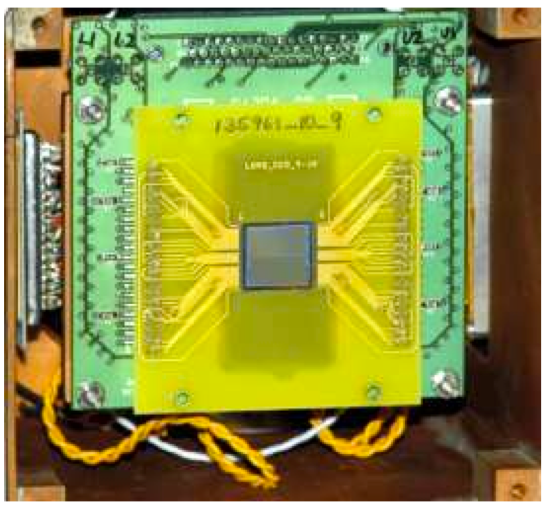Today’s Astrobite is a guest post by Elisa Chisari, a rising fourth-year graduate student in the Department of Astrophysical Sciences at Princeton University. Her research focuses in galaxy clusters and the intrinsic alignment of clusters and galaxies. In general, Elisa is interested in cosmology and the large-scale structure of the Universe. Elisa would like to thank Lucía Chisari and Sebastián Mildiner for helping her grasp the biology concepts discussed in this post.
- Authors: Drukier A., Freese K., Spergel D., Cantor C., Church G., Sano T.
- Title: New Dark Matter Detectors using DNA for Nanometer Tracking.
Introduction
Dark matter is ubiquitous. What is it? We are not yet sure. We hypothesize it exists to explain many of the physical phenomena we observe in the Universe. In a nutshell, it looks like the Universe should have much more matter than we actually see, hence the need for “dark” matter. All of the luminous (light-emitting) matter cannot account for the prompt formation of structure in the Universe, gravitational lensing, the rotational velocity curves of galaxies, etc. Our best bet is that dark matter is made of “Weakly Interacting Massive Particles” (WIMPs). If our theories are correct, our Galaxy should be embedded in a halo of WIMPs. This means that the Solar System crosses a “wind” of WIMPs as it orbits the center of the Galaxy.
Even if dark matter interacts only weakly and gravitationally, it would still be possible to directly detect dark matter. Indeed, many experiments have attempted to do so. Some experiments claim to have made this detection already (DAMA/LIBRA, COGENT, CRESST-II), but those results have been controversial for quite some time because they are in conflict with the results from other experiments such as XENON and CDMS. The full situation is nicely explained in this astrobite.
The Paper
In this paper, a multidisciplinary group of researchers present an interesting concept of an experiment that would use single stranded DNA to detect WIMP dark matter. The idea is simple: a dark matter particle swiftly hits a target atom, causing the atom to fly away and collide with a DNA strand on its trajectory. The blow from the atom severs the DNA strand at the point of impact. If the original sequence of bases in the DNA strand is known, then scientists can sequence the severed piece in order to determine exactly where the atom hit. If the fact that DNA is severed by a recoiling atom worries you, read this astrobite.
The Experiment

Schematic of the DNA-based WIMP detector. The gold square at the top represents the grid of gold atoms and the wiggly lines hanging below are the strands of DNA. The orange balls are weights at the ends of the DNA strands. The weights will ensure that the severed DNA strands fall down into the collector. Figure 2 from Drukier et al. 2012.
The highlights of the experimental design are the following. First, you would need a target for the WIMP to hit. This would be a thin layer of atoms covering one square micron. You could decide to use gold atoms like the authors propose or use your favorite element instead. The expected results of the experiment will depend on the atomic charge of the atom.
In addition to the grid of gold atoms, you would need to construct a bundle of single stranded DNA hanging down from the gold layer in a grid pattern as shown in the figure at right. A gold atom ejected by the collision with a WIMP would traverse the DNA forest and shave the branches on its way. Each DNA strand would have a weight at the bottom, so that it would fall into a collector each time it breaks. The collector would be removed periodically to identify the severed DNA strands.
The experiment would actually consist of several modules forming a grid pattern. In each module you would have a thin layer of gold and hanging from it, bundles of single stranded DNA. The strands would be identical for approximately 90% of their length, but the last 20-100 bases at the bottom of the strands would be different for each module. From the fragments of broken DNA retrieved from the collector, you would be able to reconstruct the path of the target particle. This experimental set-up guarantees that you will have micrometer resolution in the plane of the gold layer and nanometer resolution in the direction of the DNA strands. The reason for the enhanced resolution in the vertical direction is that the typical separation between bases along the DNA strand is less than a nanometer. In comparison, current experiments can only achieve micrometer precision.
Advantages
There are many advantages to this experimental set-up in comparison to current dark matter direct detection experiments. The first advantage is that you could reconstruct the path of the recoiling target very precisely. Knowing the path, you would be able to tell from which direction the WIMP came from. This is very important because if indeed our Solar System traverses a WIMP wind on its way around the Galaxy, the velocity of the WIMPs with respect to the Earth should have an annual modulation as predicted in this paper in 1986. In the same spirit, one would expect a daily modulation as the Earth rotates and the lab goes a bit more slowly or a bit faster with respect to the WIMP wind. If we detect at least the annual modulation, we would have clear evidence for the existence of WIMP dark matter.
Another advantage of using DNA for dark matter detection is that each severed DNA strand can be replicated by a technique called Polymerase Chain Reaction to amplify the DNA by many, many, many orders of magnitudes. Moreover, the experiment could be operated at room temperature, while most other dark matter experiments require low temperatures to function. And you don’t need much space either! You might be able to fit the whole apparatus in your bedroom. Isn’t that convenient? In comparison, the next generation of the XENON experiment would require 1 ton of gas and significantly more space.
Finally, the energy threshold of this experiment could be as low as 0.5 keV, which would allow you to probe low mass dark matter candidates with energies less than 10 GeV. Claimed detections of dark matter to date seem to hint at the mass of the dark matter particle being approximately 10 GeV. If you have been reading a lot about dark matter detection, you probably already know that a lot of time and effort goes into rejecting signals that mimic a WIMP collision in this kind of experiments. A DNA tracker would in principle be more efficient in rejecting background signals, but further experimentation will be needed to understand its performance.
This is a very interesting idea that came from the confluence of research being done in different fields. It will definitely be worth following the progress of this experiment!






Trackbacks/Pingbacks